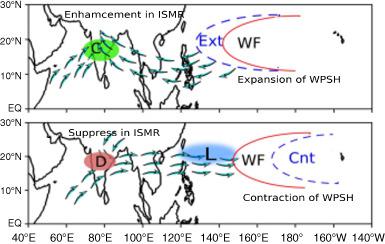当前位置:
X-MOL 学术
›
Int. J. Climatol.
›
论文详情
Our official English website, www.x-mol.net, welcomes your
feedback! (Note: you will need to create a separate account there.)
Variability of West Pacific subtropical high and its potential importance to the Indian summer monsoon rainfall
International Journal of Climatology ( IF 3.5 ) Pub Date : 2021-02-15 , DOI: 10.1002/joc.7057 Roja Chaluvadi 1, 2 , Hamza Varikoden 1 , Milind Mujumdar 1 , S. T. Ingle 2
International Journal of Climatology ( IF 3.5 ) Pub Date : 2021-02-15 , DOI: 10.1002/joc.7057 Roja Chaluvadi 1, 2 , Hamza Varikoden 1 , Milind Mujumdar 1 , S. T. Ingle 2
Affiliation

|
The variability of West Pacific subtropical high (WPSH) during the peak monsoon (July–August) season for the period 1951–2015 and its association with Indian summer monsoon rainfall (ISMR) is investigated based on various observational data sets. In the present study, we explored the long term variability of WPSH based on location index (zonal displacement of western edge) and intensity index (intensity values at the centre of WPSH). We observed significant interannual variability in zonal displacement of western flank at around 20°N, and this variability is coherent with the variability in intensity at the centre of WPSH. The significant long term trend in location index is about 1.4° per decade towards east, which is also consistent with weakening trend (−2.6 gpm per decade) in intensity index. Moreover, both the indices show contrasting trends prior to and post 1976 periods. The variability of location and intensity indices shows significant relationship with ISMR by modulating the low level circulations over the Indo-Pacific region. The present study revealed that the correlations of WPSH indices with ISMR are significant at 95% confidence level. The spatial distribution of rainfall over India during WPSH expansion years depicts the significant enhancement in southern peninsula and north-central India while a significant reduction in east central India; however, contrasting rainfall patterns are observed during WPSH contraction years. In general, changes in large-scale circulation during the westward (eastward) shift and intensification (weakening) of WPSH favour (unfavour) monsoon rainfall. The southern peninsula and northcentral India (east central India) experience surplus (deficit) rainfall during WPSH expansion due to modulation of moisture supply from the Arabian Sea, Bay of Bengal and west Pacific Ocean. Additionally, we noticed upper (lower) level divergence (convergence) and lower (upper) level convergence (divergence) during the expansion (contraction) years over the south Asian monsoon region.
中文翻译:

西太平洋副热带高压的变异性及其对印度夏季风降雨的潜在重要性
基于各种观测数据集研究了 1951-2015 年季风高峰期(7-8 月)西太平洋副热带高压(WPSH)的变化及其与印度夏季风降雨量(ISMR)的关联。在本研究中,我们基于位置指数(西部边缘的纬向位移)和强度指数(WPSH 中心的强度值)探索了 WPSH 的长期变化。我们在 20°N 附近观察到西侧纬向位移的显着年际变化,这种变化与副高中心强度的变化是一致的。位置指数的显着长期趋势是向东每十年约 1.4°,这也与强度指数的减弱趋势(-2.6 gpm/十年)一致。而且,这两个指数都显示出 1976 年之前和之后的对比趋势。通过调节印太地区的低层环流,位置和强度指数的可变性显示出与 ISMR 的显着关系。本研究表明,WPSH 指数与 ISMR 的相关性在 95% 的置信水平上是显着的。副高扩张年印度降水的空间分布表现出南半岛和中北印度显着增强,而印度中东部显着减少;然而,在副高收缩年份观察到了截然不同的降雨模式。总体来看,副高西(东)移和加强(减弱)期间大尺度环流的变化有利于(不利)通过调节印太地区的低层环流,位置和强度指数的可变性显示出与 ISMR 的显着关系。本研究表明,WPSH 指数与 ISMR 的相关性在 95% 的置信水平上是显着的。副高扩张年印度降水的空间分布表现出南半岛和中北印度显着增强,而印度中东部显着减少;然而,在副高收缩年份观察到了截然不同的降雨模式。总体来看,副高西(东)移和加强(减弱)期间大尺度环流的变化有利于(不利)通过调节印太地区的低层环流,位置和强度指数的可变性显示出与 ISMR 的显着关系。本研究表明,WPSH 指数与 ISMR 的相关性在 95% 的置信水平上是显着的。副高扩张年印度降水的空间分布表现出南半岛和中北印度显着增强,而印度中东部显着减少;然而,在副高收缩年份观察到了截然不同的降雨模式。总体来看,副高西(东)移和加强(减弱)期间大尺度环流的变化有利于(不利)本研究表明,WPSH 指数与 ISMR 的相关性在 95% 的置信水平上是显着的。副高扩展年间印度降水的空间分布表现出半岛南部和印度中北部显着增强,而印度中东部显着减少;然而,在副高收缩年份观察到了截然不同的降雨模式。总体来看,副高西(东)移和加强(减弱)期间大尺度环流的变化有利于(不利)本研究表明,WPSH 指数与 ISMR 的相关性在 95% 的置信水平上是显着的。副高扩展年间印度降水的空间分布表现出半岛南部和印度中北部显着增强,而印度中东部显着减少;然而,在副高收缩年份观察到了截然不同的降雨模式。总体来看,副高西(东)移和加强(减弱)期间大尺度环流的变化有利于(不利)在副高收缩年观察到对比的降雨模式。总体来看,副高西(东)移和加强(减弱)期间大尺度环流的变化有利于(不利)在副高收缩年观察到对比的降雨模式。总体来看,副高西(东)移和加强(减弱)期间大尺度环流的变化有利于(不利))季风降雨。由于来自阿拉伯海、孟加拉湾和西太平洋的水分供应的调制,南半岛和印度中北部(印度中东部)在 WPSH 扩张期间经历了盈余(亏缺)降雨。此外,我们注意到在南亚季风区的扩张(收缩)年期间,上(下)层发散(收敛)和下(上)层收敛(发散)。
更新日期:2021-02-15
中文翻译:

西太平洋副热带高压的变异性及其对印度夏季风降雨的潜在重要性
基于各种观测数据集研究了 1951-2015 年季风高峰期(7-8 月)西太平洋副热带高压(WPSH)的变化及其与印度夏季风降雨量(ISMR)的关联。在本研究中,我们基于位置指数(西部边缘的纬向位移)和强度指数(WPSH 中心的强度值)探索了 WPSH 的长期变化。我们在 20°N 附近观察到西侧纬向位移的显着年际变化,这种变化与副高中心强度的变化是一致的。位置指数的显着长期趋势是向东每十年约 1.4°,这也与强度指数的减弱趋势(-2.6 gpm/十年)一致。而且,这两个指数都显示出 1976 年之前和之后的对比趋势。通过调节印太地区的低层环流,位置和强度指数的可变性显示出与 ISMR 的显着关系。本研究表明,WPSH 指数与 ISMR 的相关性在 95% 的置信水平上是显着的。副高扩张年印度降水的空间分布表现出南半岛和中北印度显着增强,而印度中东部显着减少;然而,在副高收缩年份观察到了截然不同的降雨模式。总体来看,副高西(东)移和加强(减弱)期间大尺度环流的变化有利于(不利)通过调节印太地区的低层环流,位置和强度指数的可变性显示出与 ISMR 的显着关系。本研究表明,WPSH 指数与 ISMR 的相关性在 95% 的置信水平上是显着的。副高扩张年印度降水的空间分布表现出南半岛和中北印度显着增强,而印度中东部显着减少;然而,在副高收缩年份观察到了截然不同的降雨模式。总体来看,副高西(东)移和加强(减弱)期间大尺度环流的变化有利于(不利)通过调节印太地区的低层环流,位置和强度指数的可变性显示出与 ISMR 的显着关系。本研究表明,WPSH 指数与 ISMR 的相关性在 95% 的置信水平上是显着的。副高扩张年印度降水的空间分布表现出南半岛和中北印度显着增强,而印度中东部显着减少;然而,在副高收缩年份观察到了截然不同的降雨模式。总体来看,副高西(东)移和加强(减弱)期间大尺度环流的变化有利于(不利)本研究表明,WPSH 指数与 ISMR 的相关性在 95% 的置信水平上是显着的。副高扩展年间印度降水的空间分布表现出半岛南部和印度中北部显着增强,而印度中东部显着减少;然而,在副高收缩年份观察到了截然不同的降雨模式。总体来看,副高西(东)移和加强(减弱)期间大尺度环流的变化有利于(不利)本研究表明,WPSH 指数与 ISMR 的相关性在 95% 的置信水平上是显着的。副高扩展年间印度降水的空间分布表现出半岛南部和印度中北部显着增强,而印度中东部显着减少;然而,在副高收缩年份观察到了截然不同的降雨模式。总体来看,副高西(东)移和加强(减弱)期间大尺度环流的变化有利于(不利)在副高收缩年观察到对比的降雨模式。总体来看,副高西(东)移和加强(减弱)期间大尺度环流的变化有利于(不利)在副高收缩年观察到对比的降雨模式。总体来看,副高西(东)移和加强(减弱)期间大尺度环流的变化有利于(不利))季风降雨。由于来自阿拉伯海、孟加拉湾和西太平洋的水分供应的调制,南半岛和印度中北部(印度中东部)在 WPSH 扩张期间经历了盈余(亏缺)降雨。此外,我们注意到在南亚季风区的扩张(收缩)年期间,上(下)层发散(收敛)和下(上)层收敛(发散)。


















































 京公网安备 11010802027423号
京公网安备 11010802027423号